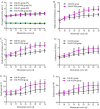Follicular development and endometrial receptivity of different androgen phenotypes in women with polycystic ovary syndrome
- PMID: 39726841
- PMCID: PMC11669509
- DOI: 10.3389/fendo.2024.1400880
Follicular development and endometrial receptivity of different androgen phenotypes in women with polycystic ovary syndrome
Abstract
Objective: Polycystic ovary syndrome (PCOS) is an important factor contributing to infertility in reproductive-aged women. Hyperandrogenism (HA) plays an important role in the pathogenesis of PCOS. This study was conducted to explore the follicular development and endometrial receptivity of different androgen phenotypes in reproductive-aged patients with PCOS.
Methods: A total of 268 PCOS patients with infertility were recruited and divided into two groups according to the different androgen phenotypes in this study: abnormal menstruation and hyperandrogenism (AM-HA group, n = 127) and abnormal menstruation and polycystic ovarian morphology (AM-PCOM group, n = 141). The follicular development, endometrial receptivity, pregnancy rate, and live birth rate during the natural menstrual cycle were compared between the two groups.
Results: The number of dominant follicles, number of ovulations, and normal ovulation rate in the AM-HA group were significantly lower compared with those in the AM-PCOM group (p < 0.05). The endometrial thickness (ET), endometrial volume (EV), vascularization index (VI), flow index (FI), and vascularization flow index (VFI) on days 14 to 24 of the menstrual cycle before ovulation were significantly lower in the AM-HA group than in the AM-PCOM group (p < 0.05). The endometrial VI, FI, and VFI, the integrin αvβ3, and VEGF concentrations in the uterine fluid during the implantation window were significantly lower in the AM-HA group compared with the AM-PCOM group (p < 0.05). However, no statistically significant differences were observed in the uterine artery blood flow parameters, ET and EV, between the two groups (p > 0.05). The biochemical pregnancy rate, clinical pregnancy rate, ongoing pregnancy rate, and live birth rate in the AM-HA group were significantly lower compared with those in the AM-PCOM group (p < 0.05).
Conclusion: PCOS patients with the AM-HA phenotype were vulnerable to ovulation disorders and impaired endometrial receptivity, which resulted in reduced pregnancy rate. Treatment with HA is likely to become an effective approach for improving endometrial receptivity and fecundity disorders in patients with PCOS.
Keywords: endometrial receptivity; follicular development; hyperandrogenism; infertility; polycystic ovary syndrome; reproductive-aged women.
Copyright © 2024 Wen, Wang and Lv.
Conflict of interest statement
The authors declare that the research was conducted in the absence of any commercial or financial relationships that could be construed as a potential conflict of interest.
Figures



Similar articles
-
Letrozole Versus Clomiphene Citrate and Natural Cycle: Endometrial Receptivity During Implantation Window in Women With Polycystic Ovary Syndrome.Front Endocrinol (Lausanne). 2021 Jan 18;11:532692. doi: 10.3389/fendo.2020.532692. eCollection 2020. Front Endocrinol (Lausanne). 2021. PMID: 33537000 Free PMC article. Clinical Trial.
-
Metabolic characteristics of different phenotypes in reproductive-aged women with polycystic ovary syndrome.Front Endocrinol (Lausanne). 2024 Jul 23;15:1370578. doi: 10.3389/fendo.2024.1370578. eCollection 2024. Front Endocrinol (Lausanne). 2024. PMID: 39109080 Free PMC article.
-
Steroid metabolome profiling of follicular fluid in normo- and hyperandrogenic women with polycystic ovary syndrome.J Steroid Biochem Mol Biol. 2021 Feb;206:105806. doi: 10.1016/j.jsbmb.2020.105806. Epub 2020 Dec 16. J Steroid Biochem Mol Biol. 2021. PMID: 33340681
-
The Disorders of Endometrial Receptivity in PCOS and Its Mechanisms.Reprod Sci. 2022 Sep;29(9):2465-2476. doi: 10.1007/s43032-021-00629-9. Epub 2021 May 27. Reprod Sci. 2022. PMID: 34046867 Review.
-
An Update on the Progress of Endometrial Receptivity in Women with Polycystic Ovary Syndrome.Reprod Sci. 2022 Aug;29(8):2136-2144. doi: 10.1007/s43032-021-00641-z. Epub 2021 Jun 2. Reprod Sci. 2022. PMID: 34076874 Review.
References
-
- Balen AH, Morley LC, Misso M, Franks S, Legro RS, Wijeyaratne CN, et al. . The management of anovulatory infertility in women with polycystic ovary syndrome: an analysis of the evidence to support the development of global WHO guidance. Hum Reprod Update. (2016) 22:687–708. doi: 10.1093/humupd/dmw025 - DOI - PubMed
MeSH terms
Substances
LinkOut - more resources
Full Text Sources
Medical

